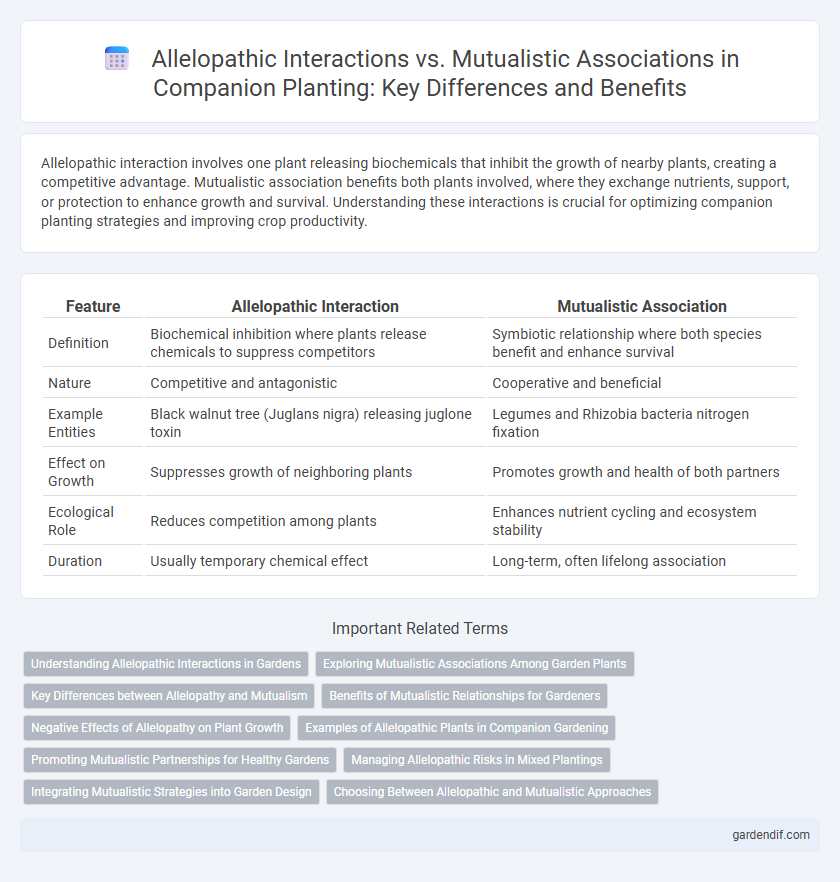
Allelopathic interaction vs mutualistic association Illustration
Allelopathic interaction involves one plant releasing biochemicals that inhibit the growth of nearby plants, creating a competitive advantage. Mutualistic association benefits both plants involved, where they exchange nutrients, support, or protection to enhance growth and survival. Understanding these interactions is crucial for optimizing companion planting strategies and improving crop productivity.
Table of Comparison
| Feature | Allelopathic Interaction | Mutualistic Association |
|---|---|---|
| Definition | Biochemical inhibition where plants release chemicals to suppress competitors | Symbiotic relationship where both species benefit and enhance survival |
| Nature | Competitive and antagonistic | Cooperative and beneficial |
| Example Entities | Black walnut tree (Juglans nigra) releasing juglone toxin | Legumes and Rhizobia bacteria nitrogen fixation |
| Effect on Growth | Suppresses growth of neighboring plants | Promotes growth and health of both partners |
| Ecological Role | Reduces competition among plants | Enhances nutrient cycling and ecosystem stability |
| Duration | Usually temporary chemical effect | Long-term, often lifelong association |
Understanding Allelopathic Interactions in Gardens
Allelopathic interactions in gardens involve the release of biochemicals by plants that inhibit the growth of neighboring species, affecting biodiversity and plant health. Understanding these chemical exchanges helps gardeners select compatible companion plants that minimize negative effects and enhance garden productivity. Recognizing allelopathic influences supports sustainable planting strategies, improving soil quality and overall ecosystem balance.
Exploring Mutualistic Associations Among Garden Plants
Mutualistic associations among garden plants enhance growth and resilience by facilitating nutrient exchange, pollination, and pest protection, contrasting with allelopathic interactions that involve chemical inhibition. Examples include legumes partnering with nitrogen-fixing bacteria and flowering plants attracting pollinators vital for crop yield. Understanding these symbiotic relationships helps gardeners optimize companion planting strategies for healthier, more productive ecosystems.
Key Differences between Allelopathy and Mutualism
Allelopathic interaction involves one organism releasing biochemicals that inhibit the growth or survival of neighboring plants, demonstrating a competitive mechanism that reduces resource availability. In contrast, mutualistic association features a symbiotic relationship where both organisms benefit, enhancing nutrient uptake, growth, or protection. Key differences include the nature of interaction--antagonistic in allelopathy versus cooperative in mutualism--and the impact on the involved species' fitness and ecosystem dynamics.
Benefits of Mutualistic Relationships for Gardeners
Mutualistic associations between companion plants enhance nutrient uptake, pest resistance, and soil health, creating a balanced ecosystem that supports sustainable gardening. Unlike allelopathic interactions, which inhibit certain plants through chemical means, mutualism fosters cooperation, leading to higher crop yields and reduced need for chemical fertilizers or pesticides. Gardeners benefit from improved plant vigor and biodiversity, resulting in resilient, productive gardens that require less maintenance.
Negative Effects of Allelopathy on Plant Growth
Allelopathic interactions release inhibitory chemicals, known as allelochemicals, which suppress seed germination, root elongation, and nutrient uptake in neighboring plants. These negative effects reduce overall plant growth, leading to decreased biomass and impaired physiological functions. Unlike mutualistic associations that enhance plant fitness, allelopathy creates competitive disadvantages, limiting biodiversity and crop productivity.
Examples of Allelopathic Plants in Companion Gardening
Allelopathic plants release biochemicals that inhibit the growth of nearby plants, making them useful in companion gardening for natural weed control and pest management. Examples of allelopathic plants used in companion gardening include black walnut (Juglans nigra), which emits juglone to suppress weeds, and marigold (Tagetes spp.), known for its thiophenes that deter nematodes and harmful insects. Incorporating these plants strategically helps create a balanced garden ecosystem by reducing competition while protecting crop health.
Promoting Mutualistic Partnerships for Healthy Gardens
Promoting mutualistic partnerships in gardens enhances plant health by fostering beneficial interactions like mycorrhizal fungi colonization and nitrogen-fixing bacteria associations, which improve nutrient uptake and soil fertility. Allelopathic interactions, where plants release chemicals that inhibit neighbors, can suppress growth and biodiversity, reducing ecosystem resilience. Prioritizing mutualism over allelopathy cultivates a balanced environment that supports robust plant development and sustainable garden ecosystems.
Managing Allelopathic Risks in Mixed Plantings
Managing allelopathic risks in mixed plantings requires understanding how allelochemicals released by certain species inhibit the growth of neighboring plants. Selecting companion plants that exhibit mutualistic associations can counteract these negative effects by enhancing nutrient exchange and soil health. Employing crop rotation and introducing microbial inoculants further mitigates allelopathic stress, promoting sustainable plant coexistence.
Integrating Mutualistic Strategies into Garden Design
Integrating mutualistic strategies into garden design enhances plant health and biodiversity by promoting symbiotic relationships such as mycorrhizal fungi and nitrogen-fixing bacteria. This approach contrasts with allelopathic interactions, where certain plants release biochemicals that inhibit the growth of neighboring species, potentially reducing diversity. Utilizing mutualistic companions supports nutrient cycling and pest resistance, creating a resilient, sustainable garden ecosystem.
Choosing Between Allelopathic and Mutualistic Approaches
Choosing between allelopathic interaction and mutualistic association depends on the specific companion planting goals. Allelopathic plants release biochemicals that suppress pests or weeds, providing a protective barrier but potentially inhibiting nearby crops. Mutualistic associations enhance nutrient exchange and pollination through symbiotic partners, promoting overall plant health and yield in companion systems.
Allelopathic interaction vs mutualistic association Infographic

 gardendif.com
gardendif.com